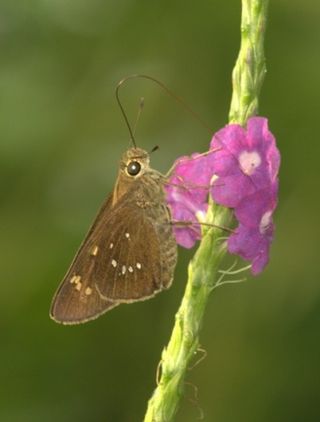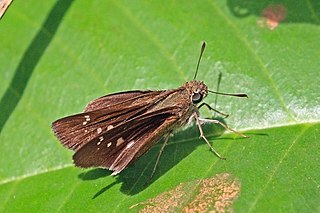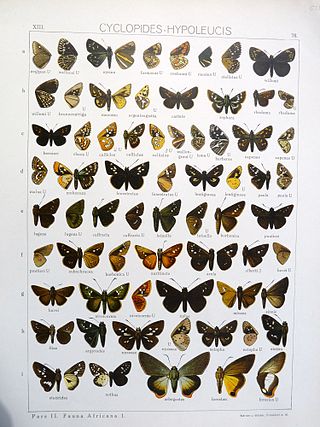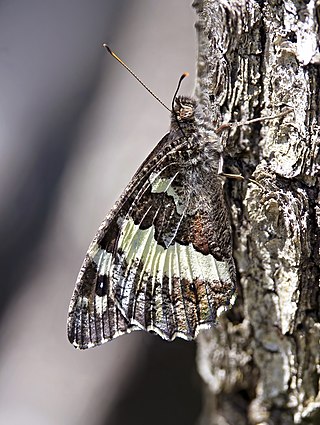
Melanargia galathea, the marbled white, is a medium-sized butterfly in the family Nymphalidae. Despite its common name and appearance, this butterfly is one of the "browns", of the subfamily Satyrinae.

Erionota thrax, the palm redeye or the banana skipper, is a species of butterfly belonging to the family Hesperiidae. It is found from India, through south-eastern Asia to Papua New Guinea. In the north it is found up to southern China. It is an introduced species on various Pacific islands, including the Solomon Islands and Hawaii. It has also been recorded from Mauritius.

Gegenes nostrodamus, commonly known as the dingy swift, light pygmy skipper, Mediterranean skipper or veloz de las rieras, is a butterfly belonging to the family Hesperiidae. It is found from the Mediterranean Sea, through Anatolia to Turkestan and India.

Halpe porus, commonly known as Moore's ace, is a species of butterfly in the family Hesperiidae, found in India.

Pelopidas conjuncta, the conjoined swift, is a species of butterfly belonging to the family Hesperiidae found in India.

Pelopidas mathias, the dark small-branded swift, small branded swift, lesser millet skipper or black branded swift, is a butterfly belonging to the family Hesperiidae. It is found throughout much of south, southeast and East Asia, and as far as the Philippines. It is also present in tropical Africa and Arabia.

Idaea subsericeata, the satin wave, is a moth of the family Geometridae. The species was first described by Adrian Hardy Haworth in 1809. It is found from central and southern Europe, North Africa, Asia Minor to Transcaspia.

Minucia lunaris, the lunar double-stripe or brown underwing, is a species of moth in the family Erebidae. The species was first described by Michael Denis and Ignaz Schiffermüller in 1775 and is found in Asia, Europe and North Africa.

Synthymia is a genus of moths of the family Noctuidae. It contains only one species, Synthymia fixa, The Goldwing, which is found in southern Europe and North Africa.

Erynnis marloyi, commonly known as the inky skipper, is a species of butterfly in the family Hesperiidae. It is found in south-eastern Europe across Asia Minor to Syria, Turkey, Lebanon, southern Iran and Chitral, Pakistan.

Muschampia proto, the sage skipper, is a butterfly of the family Hesperiidae. It is found in Morocco, Algeria, the Iberian Peninsula and southern France.

Gegenes pumilio, the pigmy skipper or dark Hottentot, is a butterfly of the family Hesperiidae. It is found from the coasts of the Mediterranean Sea through Anatolia to the Himalaya and south in the whole of Africa.

Borbo borbonica, the borbo skipper, Zeller's skipper or olive haired swift, is a butterfly of the family Hesperiidae. It is found along the southern coasts of the Mediterranean Sea including SW Spain, but mainly in Syria, Arabia, Africa, Mauritius and Réunion.

Parnara bada, the African straight swift, grey swift or Ceylon swift, is a butterfly of the family Hesperiidae. It is found in south-east Asia, from India through China to Indonesia, as well as the north-east coast of Australia.

Borbo fatuellus, the long horned swift, long horned skipper or foolish swift, is a butterfly of the family Hesperiidae. It is found in tropical Africa and south-western Arabia. The habitat consists of wet forests, moist woodland and coastal bush.

Gegenes niso, the common Hottentot skipper or plain Hottentot skipper, is a butterfly of the family Hesperiidae. It is found in Africa. It is found in a wide range of habitats, including savanna, grassland and open patches in forests.

Gegenes hottentota, the marsh Hottentot skipper, Hottentot skipper or Latreille's skipper, is a butterfly of the family Hesperiidae. It is found in Africa and south-western Arabia. The habitat consists of marshy areas with thick grass, especially in valleys.

Acraea esebria, the dusky acraea, is a butterfly of the family Nymphalidae from southern and eastern Africa.

Brintesia is a monotypic butterfly genus in the family Nymphalidae and subfamily Satyrinae. Its one species is Brintesia circe, the great banded grayling.



















